
-
Find the right food for your petTake this quiz to see which food may be the best for your furry friend.Find the right food for your petTake this quiz to see which food may be the best for your furry friend.Featured products
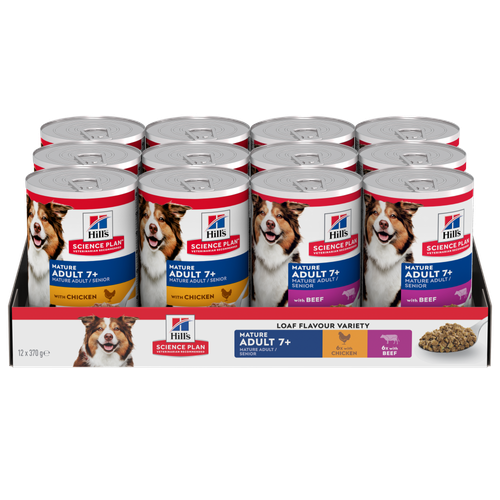 Mature Adult Dog Food
Mature Adult Dog FoodHill's Science Plan Mature Adult Multipack Wet Dog Food with Chicken & Beef are complete premium pet foods for mature adult dogs from 7 years. Your dog will love these deliciously smooth and savoury minced loaves, formulated to deliver the appropriate amount of energy to support the needs of adult dogs.
Shop Now Puppy Food
Puppy FoodHill's Science Plan Puppy Multipack Wet Dog Food with Chicken & Beef are complete premium pet foods for growing puppies from weaning until 1 year old and for pregnant and nursing dogs. Your puppy will love these deliciously smooth and savoury minced loaves, formulated for balanced nutrition and overall health.
Shop Now Adult Wet Dog Food with Beef
Adult Wet Dog Food with BeefHill's Science Plan Adult Multipack Wet Dog Food with Chicken, Beef & Turkey are complete premium pet foods for adult dogs from 1 year. Your dog will love these deliciously smooth and savoury minced loaves, formulated for balanced nutrition and overall health.
Shop NowFeatured products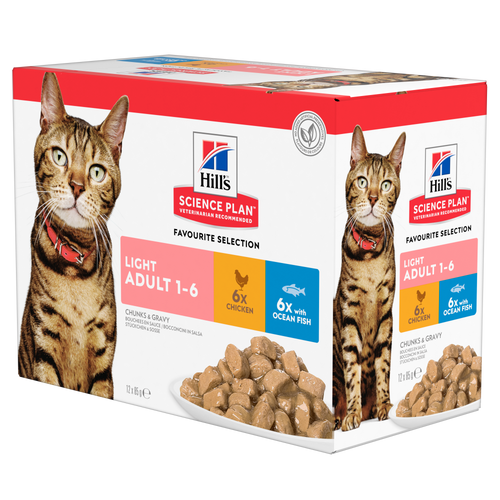 Light Adult Multipack Wet Cat Food with Chicken & Ocean Fish
Light Adult Multipack Wet Cat Food with Chicken & Ocean FishTender chicken chunks in gravy for cats, with L-carnitine and fewer calories for ideal weight management. Packed with high-quality protein, omega-6s, and vitamin E for shiny fur and healthy skin.
Shop Now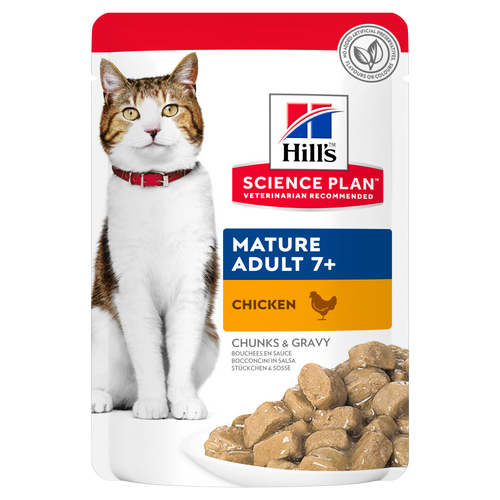 Mature Adult Wet Cat Food with Chicken
Mature Adult Wet Cat Food with Chicken
Tender chicken chunks in gravy for mature adult cats. Made with easy-to-digest ingredients, high-quality protein for lean muscle maintenance and antioxidant vitamins C+E for optimal health.
Shop Now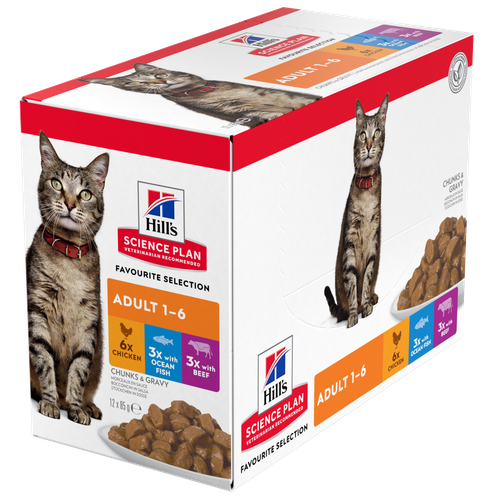 Adult Multipack Wet Cat Food with Beef, Ocean Fish & Chicken
Adult Multipack Wet Cat Food with Beef, Ocean Fish & ChickenTender chunks in gravy for cats, with high-quality protein to maintain lean muscle. With vitamin E and omega-3s & -6s for healthy skin and balanced minerals to support healthy vital organs.
Shop Now -
Dog
- Dog Tips & Articles
-
Health Category
- Weight
- Food & Environmental Sensitivities
- Urinary
- Digestive
- Joint
- Kidney
-
Life Stage
- Puppy Nutrition
- Adult Nutrition
- Senior Nutrition
Cat- Cat Tips & Articles
-
Health Category
- Weight
- Skin & Food Sensitivities
- Urinary
- Digestive
- Kidney
-
Life Stage
- Kitten Nutrition
- Adult Nutrition
Featured articles Show some love with wet foods: a great choice for pets with health issues
Show some love with wet foods: a great choice for pets with health issuesShow some love with wet foods: a great choice for pets with health issues.
Read More The Right Diet For Your Pet
The Right Diet For Your PetIn people, the right diet is very important. If you are eating the wrong way for your metabolism, activity level, age and lifestyle you could end up with health issues.
Read More The Incredible Science Behind Your Pet's Microbiome
The Incredible Science Behind Your Pet's MicrobiomeLearn what your pet's microbiome is, how it contributes to your pet's gut and overall health, and why nutrition is important in maintaining healthy microbiomes.
Read More -


Many people wonder if cats, like humans, can get urinary tract infections and cystitis. They can in fact get both, however urinary tract infections are pretty rare in cats.
Inflammation and infection are two different things. Infection is caused by organisms such as bacteria and viruses entering one or more parts of the body. The presence of these organisms stimulates the body’s immune system to combat them. Inflammation is the body’s response to injury and infection. Inflamed tissue is usually red and swollen and feels hot. This is because the body sends blood to the area to get the healing white blood cells, platelets and blood clotting factors there as quickly as possible. Infection will certainly cause inflammation but inflammation can just be due to trauma such as a grazed knee, without infection.
Cystitis, which means inflammation of the bladder, is very common indeed. Infections and other more common causes of cystitis are grouped together and called Feline Lower Urinary Tract Disease, or FLUTD.
When trying to understand FLUTD, it’s really useful to know how cats evolved and look at their natural behaviour when left to their own devices. Cats are descended from desert-dwelling felines. This means they have evolved to be very good at conserving water and have naturally very concentrated urine. Cats are also, by nature, solitary animals, guarding a large territory from other cats to protect their precious resources of food and water. Sometimes it’s difficult for social creatures like humans to understand that some animals prefer to live alone. Cats tend to see other cats as a threat, not something to be welcomed into their territory!
What causes cystitis in cats?
Feline idiopathic cystitis (FIC) is the most common cause of FLUTD in cats. The word “idiopathic” means something that arises with no apparent cause. However, feline idiopathic cystitis is now much more commonly called stress cystitis because we know that it is virtually always caused by stress.
But how can my cat be stressed when they just sleep all day? Well, cats are really subtle communicators and are really good at hiding stress and conflict. In fact, some cats even do what’s called “sham sleeping,” where they pretend to be asleep to avoid stressful situations, such as confronting another cat in the house that may be bullying them.
The main causes or triggers of stress cystitis are:
Multi-cat households. Unless your cats groom each other and sleep cuddled up together, they are most likely not great friends. Cats are not inherently social creatures, so living in close quarters with another cat can be a huge source of stress.
Neighbourhood cats. Even if your cat is single, you may live somewhere with a high number of cats. Conflict over the garden or other cats coming through the cat flap or open doors in summer can be very stressful.
Indoor cats. Being kept entirely indoors can be a major cause of stress. Cats like a large territory and freedom to explore.
Visitors. Susceptible cats may be very sensitive to visitors, especially children who may make noise or try to pick them up and cuddle them.
Holidays. Stress can be triggered by a cattery stay or even just the owners being away on holiday.
House changes. Moving house or having work done to your current house can be easy triggers for some cats who thrive on familiarity and routine.
A new baby. The unfamiliar objects, smells and sounds that come with a new baby are also triggers to animals as sensitive as cats.


Tasty Tips
Why does stress cause cystitis?
Stress causes the release of certain steroids, which in the short term can be beneficial, but when released chronically can suppress the immune system and negatively affect a number of body systems. Cats with stress may have other signs, like occasional gastrointestinal upsets (e.g. vomiting and diarrhoea). They may also have hair loss from overgrooming. Overgrooming may be a displacement behaviour to try to reduce stress, but can also be a sign of pain in the abdomen, either from cystitis in the bladder or from intestinal pain. Many stressed cats have bald patches on their bellies and between their hind legs.
Stress causes the protective layer of the bladder to become weak and damaged, allowing urine to come into contact with the sensitive tissues of the bladder wall. As we said, cats tend to have very concentrated urine that is highly irritating to the bladder, so this can cause inflammation. Inflammatory cells in the bladder can form sludge or plugs and block the outflow of urine. This is a medical emergency because cats can go into renal failure or rupture their bladders if they become blocked. Both of these events can be rapidly fatal. This is much more common in male cats due to their very narrow urethra.
Being stressed also changes the pH of the urine and. As this increases, some cats will develop struvite crystals in their bladder, which can clump together to make bladder stones, another risk for blockage. Their very concentrated urine exacerbates this clumping because the minerals that make the crystals are in close contact.
Other causes of FLUTD
Although stress cystitis is the major cause of FLUTD in cats, there are other things that can cause it. Some of these are:
- Kidney stones and urinary crystals and stones. Calcium oxalate crystals, for example, may form if your cat has high blood calcium concentrations or kidney disease. High levels of urate may be the result of liver disease and can also cause bladder stones.
- Cancer in the urinary tract may cause signs of cystitis.
- Urinary tract infection (UTI). As we said at the start, UTIs in cats are pretty rare. Their super-concentrated urine makes it virtually impossible for bacteria to grow. However, it can happen and is much more common in older cats. This is because their urine tends to become more dilute as their renal function reduces, and this can allow bacteria to take hold.
Signs and symptoms of FLUTD
You should seek veterinary attention if you see any of the following signs:
Blood in the urine or a pink tinge to urine.
Straining to urinate but not producing a normal stream. If your cat is passing no urine, this is a medical emergency.
Vocalising/yowling while urinating, which can be a sign of severe discomfort.
Loss of house training or inappropriate urinating in the house.
Increased frequency of urination.
Gritty deposits around the rear end.
Overgrooming of the belly.
Treatment of FLUTD
Obviously some of this will depend on the exact cause. Your vet will want to get a urine sample and blood tests and may want to do an x-ray or an ultrasound scan of the bladder. If a UTI is present, antibiotics will be prescribed. Treatment and prevention of recurrence may include:
- Increased water intake. This is absolutely crucial in all cats with bladder issues. Diluting the urine makes it less irritating to the bladder and will make crystals much less likely to form. Using wet food with added water or soaking kibbles can help if your cat doesn’t drink much. Water fountains and multiple water stations also help.
- Nutrition. Your vet may recommend a therapeutic diet. These can help dissolve stones and crystals, depending on the type, and have altered protein and mineral content to reduce the building blocks for crystals. They also have high levels of omega oils from fish to reduce inflammation and antioxidants to slow cell damage.
- Weight loss and exercise. Obese cats are much more prone to FLUTD, so your vet may recommend a combination diet to address their weight and their FLUTD. Being sedentary may contribute to weight issues and allows urine to sit in the bladder for long periods. Encouraging exercise and play can really help.
- Surgery. Your vet may need to sedate your cat in order to surgically unblock their urinary tract or remove calcium oxalate stones. This would usually be followed by a special food to prevent recurrence.
- Repeat urine sampling. Your vet will need to monitor your cat to make sure the cystitis has resolved and any stones have been dissolved. This will involve repeated urine samples and possibly imaging.
- Addressing stress in the environment. The fancy phrase for this is Multi-Modal Environmental Modification (MMEM), but it just means reducing stress at home. You can do this by:
Giving your cat access to the outdoors if at all possible.
Placing multiple food and water stations in quiet, separate places around the house so there is never conflict over food or water. You need one more of each than the number of cats you have.
Placing multiple litter trays in other quiet locations. Again, place one more than the number of cats. Offer trays even if you have a cat flap.
Placing furniture and shelves in corridors where your cats may have to pass each other. This lets them move freely at different levels without conflict.
Use pheromone plugins to make your cats feel more relaxed.
FLUTD is a complex condition, but with fast intervention and good teamwork, your cat can have a great outcome and hopefully never experience it again. As with all things, prevention is better than cure. Think twice about having multiple cats and if you do, talk to your vet or follow the tips above to keep the house as harmonious and stress-free as possible from the outset. Avoiding stress for your cat will make your life much more stress-free too!
Reviewed by Dr. Hein Meyer, DVM, PhD, Dipl-ECVIM-CA and Dr. Emma Milne BVSc FRCVS


One of our staff authors prepared this article for you
Related products

Tender chicken chunks in gravy for cats, with L-carnitine and fewer calories for ideal weight management. Packed with high-quality protein, omega-6s, and vitamin E for shiny fur and healthy skin.

Tender chicken chunks in gravy for mature adult cats. Made with easy-to-digest ingredients, high-quality protein for lean muscle maintenance and antioxidant vitamins C+E for optimal health.
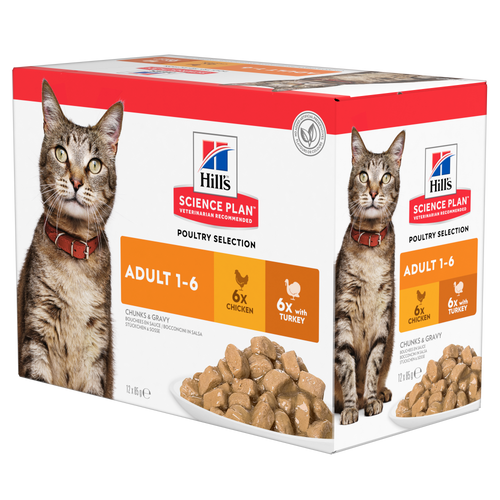

Tender chunks in gravy for cats, with high-quality protein to maintain lean muscle. With vitamin E and omega-3s & -6s for healthy skin and balanced minerals to support healthy vital organs.
Related articles

Find out about how you can support your cat's digestion to boost overall health. Diet is key to a long and happy life for your cat, so discover what you can do.

Feeding time can be a wonderful bonding opportunity for you and your cat. Find out how to make the most of it and create a healthy habit with HIll's Pet UK.

Find the right Hill

Discover what you can do to spot and support a sensitive cat stomach. See what routines and food you can implement to help your cat be happy and healthy.

Put your cat on a diet without them knowing
Our low calorie formula helps you control your cat's weight. It's packed with high-quality protein for building lean muscles, and made with purposeful ingredients for a flavourful, nutritious meal. Clinically proven antioxidants, Vitamin C+E, help promote a healthy immune system.
Put your cat on a diet without them knowing
Our low calorie formula helps you control your cat's weight. It's packed with high-quality protein for building lean muscles, and made with purposeful ingredients for a flavourful, nutritious meal. Clinically proven antioxidants, Vitamin C+E, help promote a healthy immune system.

